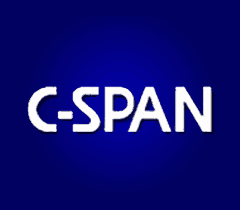 C-SPAN is really quite incredible when you think about it. When I was growing up in the 70s, there was nothing like it. Like most other Americans, my informational inputs about national news and politics were limited to what a couple of old white dudes in bad suits delivered each night around 6:30 on the three VHF channels I had access to. And no national newspapers were delivered to my small town in rural Illinois, so I had to rely on crummy local papers to fill the void via whatever national reporting they offered, which wasn't much.
C-SPAN is really quite incredible when you think about it. When I was growing up in the 70s, there was nothing like it. Like most other Americans, my informational inputs about national news and politics were limited to what a couple of old white dudes in bad suits delivered each night around 6:30 on the three VHF channels I had access to. And no national newspapers were delivered to my small town in rural Illinois, so I had to rely on crummy local papers to fill the void via whatever national reporting they offered, which wasn't much.
And then came C-SPAN. C-SPAN alone covers more political and civic-minded activity in the course of a week than most of us probably came into contact with in our entire lives just 30 years ago. Consider these data points, which Peter Kiley, Vice President of C-SPAN Networks was kind enough to help me aggregate. In the 2009 calendar year, C-SPAN provided the following amount of first run programming across their three channels:
- 8,438 overall hours of programming;
- 2,709 hours of House & Senate floor activity; and,
- 1,222 hours of House & Senate committee hearings.
Moreover, C-SPAN recently created the C-SPAN Video Library, which archives 23 years worth (1987-on) of fully searchable (and free) video content, including:
- 161,000 overall hours of programming;
- 56,600 hours of House & Senate floor activity; and,
- 20,152 of House & Senate committee hearings.
OK, let me step back and explain why I started thinking about C-SPAN. I've been invited to testify at a Federal Communications Commission hearing this Thursday on "Serving the Public Interest in the Digital Era." I suspect that one of the laments we'll hear from some of the participants is the old "deliberative democracy is dead" line. Debates about public interest regulation often take on a mythical tone as regulatory advocates wax nostalgic about some supposedly Golden Era of Civic Engagement when we were all better informed and publicly active. It's pure rubbish, as I showed in my 2005 book, Media Myths: Making Sense of the Debate over Media Ownership. (See chapter 4, "Democracy, Civic Discourse, and the 'Public Interest.'")
Nonetheless, the myth persists and often leads to calls for aggressive regulation of media markets in the name of serving "the public interest." Regulatory advocates typically claim that government must intervene and layer on regulatory mandates if citizens are to have access to the requisite amount of political programming or civic-minded content necessary for deliberative democracy to survive.
But is there really any shortage political programming or civic-minded content from which to choose today? C-SPAN's existence alone seems to prove the contrary, but it's hardly the only platform through which such content is available. Let's not forget about what the Internet has made available to us. It has given us unprecedented access to public affairs information--local, state, national, and international.
But here's the thing that a lot of "public interest" advocates always seem to ignore: Regardless of how much beneficial civic content is out there, you can't make people watch, listen, or read it if they don't want to. "Today, the scarce resource is attention, not programming," notes Ellen P. Goodman of the Rutgers-Camden School of Law. "Given the proliferation of consumer filtering and choice, these kinds of interventions are of questionable efficacy. Consumers equipped with digital selection and filtering tools are likely to avoid content they do not demand no matter what the regulatory efforts to force exposure." [Ellen P. Goodman, "Proactive Media Policy in an Age of Content Abundance," in Philip M. Napoli, ed., Media Diversity and Localism: Meaning and Metrics (2007) at 370, 374.]
And there is no reason to believe this situation has ever been different or will ever change. Writing in 1922, famed journalist Walter Lippmann noted that, "it is possible to make a rough estimate only of the amount of attention people give each day to informing themselves about public affairs," but "the time each day is small when any of us is directly exposed to information from our unseen environment." [Walter Lippmann, Public Opinion (1922), p. 53, 57.] Of course, in Lippmann's day, one could have reasonable argued that was because such content simply wasn't available to the masses. Today, by contrast, the content is available, it's just that we have a lot of other informational and entertainment outputs vying for our attention.
Absent truly repressive measures to limit choices or forcibly alter consumer media consumption patterns, it will be impossible for policymakers to force the masses to pay attention to what they want them to see or hear in an age of abundant media content and unrestricted choice. "[R]egulation cannot, in a liberal democracy, force viewers to consumer media products they do not think they want in the name of the public interest," argues Goodman.
Luckily, public officials need not resort to such repressive steps. Even if we only access C-SPAN on rare occasions, or browse political information on the Net at random intervals in the days leading up to an election, that's more information than we ever had at our disposal in those mythical "good 'ol days." We should be celebrating this fact, but I suspect a lot of people at the FCC's hearing on Thursday will be bemoaning it instead.